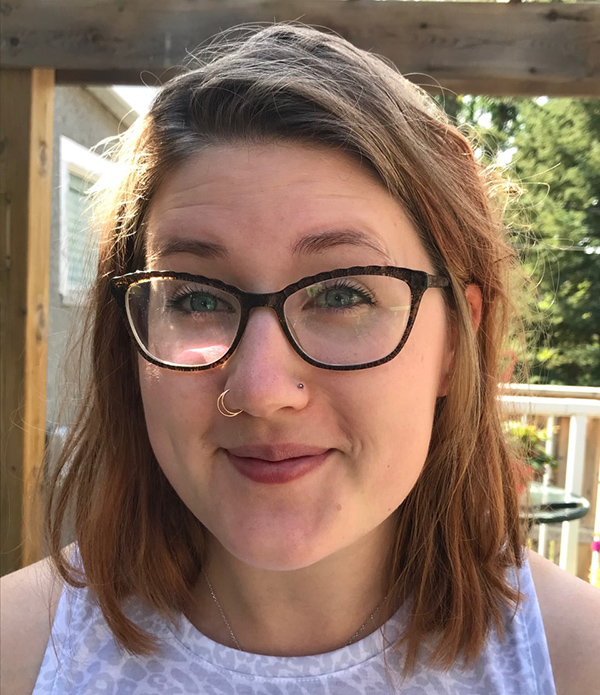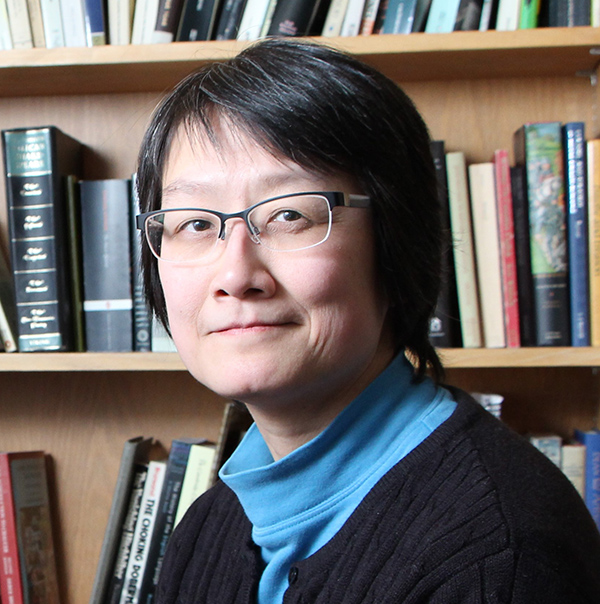USask graduate student probes mystery surrounding medieval manuscript
A University of Saskatchewan (USask) graduate student is playing detective to better understand the use and function of a medieval Latin manuscript housed in the University Library—and she may be the first person in the world to have cracked the case.
By SHANNON BOKLASCHUKA closeup look at the intricate hand-written work in the medieval manuscripts that are part of the university’s Ege leaves collection. (Photo: David Bindle)
Ariel Brecht (BA’16, CCML’16), a USask alumna who is currently pursuing a Master of Arts (MA) degree in history in the College of Arts and Science, is studying a dismembered medieval manuscript known as MS Ege 4. It is part of one of Otto Ege’s 50 Original Leaves from Medieval Manuscripts, Western Europe XII – XVI Century portfolios, which USask acquired in 1957. Brecht first encountered the leaf while on a tour of the University Archives and Special Collections during her undergraduate studies.

The Classical, Medieval, and Renaissance Studies (CMRS) class Brecht was in at the time, known as CMRS 333, was co-taught by College of Arts and Science professor Dr. Yin Liu (PhD), a faculty member in the Department of English and the current director of USask’s CMRS program. Liu told the class that she doubted the identification of the leaf, which Ege had described as a 12th-century Psalter, and suggested that determining its true identification could make a good research project.
“I decided then and there that I was going to research it for my honours project,” said Brecht. “But I discovered, after completing my undergrad project, that I would need to examine more than one leaf to understand this manuscript, so I decided to play detective and hunt down more leaves—and this scavenger hunt eventually turned into my MA thesis.”
A Psalter is a volume containing devotional materials, including the Book of Psalms, that was used for worship purposes in the Middle Ages. Brecht’s graduate research has shown that the medieval manuscript fragment she examined contains three commentaries on the Psalter by Philip the Chancellor. She also discovered that the manuscript from which the fragment originates, MS Ege 4, contains a special compilation of biblical commentaries by Philip the Chancellor and John Halgren of Abbeville, which was put together in the 13th century.
“The manuscript, as a whole, was used as a preaching aid to help medieval preachers compose sermons,” said Brecht. “What is also particularly interesting about this fragment is the words in the margins of the text. These words correspond to words found in the text proper. Many of these marginal words appear in an alphabetical index at the back of this manuscript. It is likely that these words reveal the process by which the index was created in the first place. We are literally seeing the method of creation of a medieval index.”
Brecht’s research was funded by the Social Sciences and Humanities Research Council (SSHRC), after she was awarded $17,500 over a 12-month period through a Joseph-Armand Bombardier Canada Graduate Scholarship-Master’s (CGS M). She also received travel funding from USask, which enabled her to go to the U.K. and to the University of Notre Dame in Indiana for her research.

Brecht’s master’s thesis is co-supervised by Liu and USask history professor Dr. Frank Klaassen (PhD). Liu noted that scholars around the world have been pointing out for decades that the development of reference tools in Europe was driven by innovations in preaching in the 13th century, but surprisingly few people have used this as a reason to study medieval sermon manuscripts.
“As Frank Klaassen points out, what’s really great about this project is that it started with a manuscript fragment in USask’s own Special Collections. Ariel was the first person in the world, to my knowledge, to correct previous assumptions about the date of the manuscript fragment, to figure out what the manuscript actually was, and to link this leaf to the rest of the manuscript, which was taken apart in the 1940s and now exists in bits all over North America,” said Liu.
“She was able to start from a single parchment leaf covered with heavily abbreviated Latin that’s a challenge to read, and connect it not just to the rest of the book that it came from, but also to really important intellectual innovations in medieval Europe that helped to shape the ways we manage, retrieve, and communicate information today.”
To begin her research, Brecht first transcribed the medieval text and translated it from Latin to English. She then did some Google searches to see if the text appeared in any online databases.
“Luckily, there are multiple early modern books—incunabula—of Philip’s commentaries on the Psalter that Google Books digitized, so I was able to compare my transcription against an incunabulum of Philip’s work,” she said.
“To do this research, Ariel had to read a lot of medieval Latin,” Liu noted. “The rest of us looked at the manuscript fragment and gave up. She didn’t.”

Klaassen said Brecht’s thesis involved “some very complicated and very accomplished detective work,” noting the graduate student “surprised us with just how much she was able to find out and the depth of the story she was able to tell.”
“A lot of people think that the printing press was the big revolution that enabled Europe’s transition from a medieval world to a modern one. Well, maybe—but at least as important was a set of changes that happened in the twelfth and thirteenth centuries, opening up new ways of reading,” Klaassen said.
“The manuscript Ariel is studying has built-in reference tools that help users to analyze a text and to find specific items of information and combine them in new ways. We are used to doing this now and so we take it for granted, but every time we ‘look something up’ we are assuming the types of tools that people in western Europe were just starting to invent in the Middle Ages.”
Klaassen also noted the good fortune of students like Brecht, who have the opportunity to view medieval manuscripts in person at the University Library. In the early 20th century, Otto Ege, a Cleveland book collector, removed the pages from 50 medieval manuscript books, divided the pages among 40 boxes, and sold the boxes around the world. Most of the boxes now reside in university and public library collections in the United States and Canada, including at USask.
USask President Peter Stoicheff, a literature scholar, has been lauded for his work to locate and digitally reconstruct the Ege manuscript portfolios.
“Fifteen years ago, we began here the international work of locating the other 39 boxes scattered around the world and of digitally remaking some of the original manuscript books—work that continues at a number of universities to this day. I’m excited to see the manuscripts in our Ege collection continue to attract the kind of examination Ms. Brecht is bringing to them," he said.
Brecht said she finds the manuscripts to be “utterly fascinating as historical artifacts.”
“Each one is unique. You can see and feel the love and attention that went into making these beautiful creations. They always leave me breathless,” she said. “Not only do they provide us with textual sources from antiquity, the Middle Ages, and the Renaissance, but they are also material objects in their own right. They are an important component of medieval material culture.”
Brecht recently had the opportunity to purchase her own leaf from a private collector. It is folio 127, and it contains three commentaries on the Psalter by Philip. As well, she has co-authored an article about Ege Leaf 4, housed at USask, with Liu. The article was published in a special issue of Florilegium, an annual publication devoted to the study of late Antiquity and the Middle Ages that serves as the journal of the Canadian Society of Medievalists.
Brecht expects to complete her master’s degree in early 2021 and then plans to pursue a PhD in manuscript studies. She encourages her fellow students to go to the University Library to see USask’s manuscript collection in person once the COVID-19 pandemic has ended.
“There is nothing like holding a piece of history in your hand,” she said.

